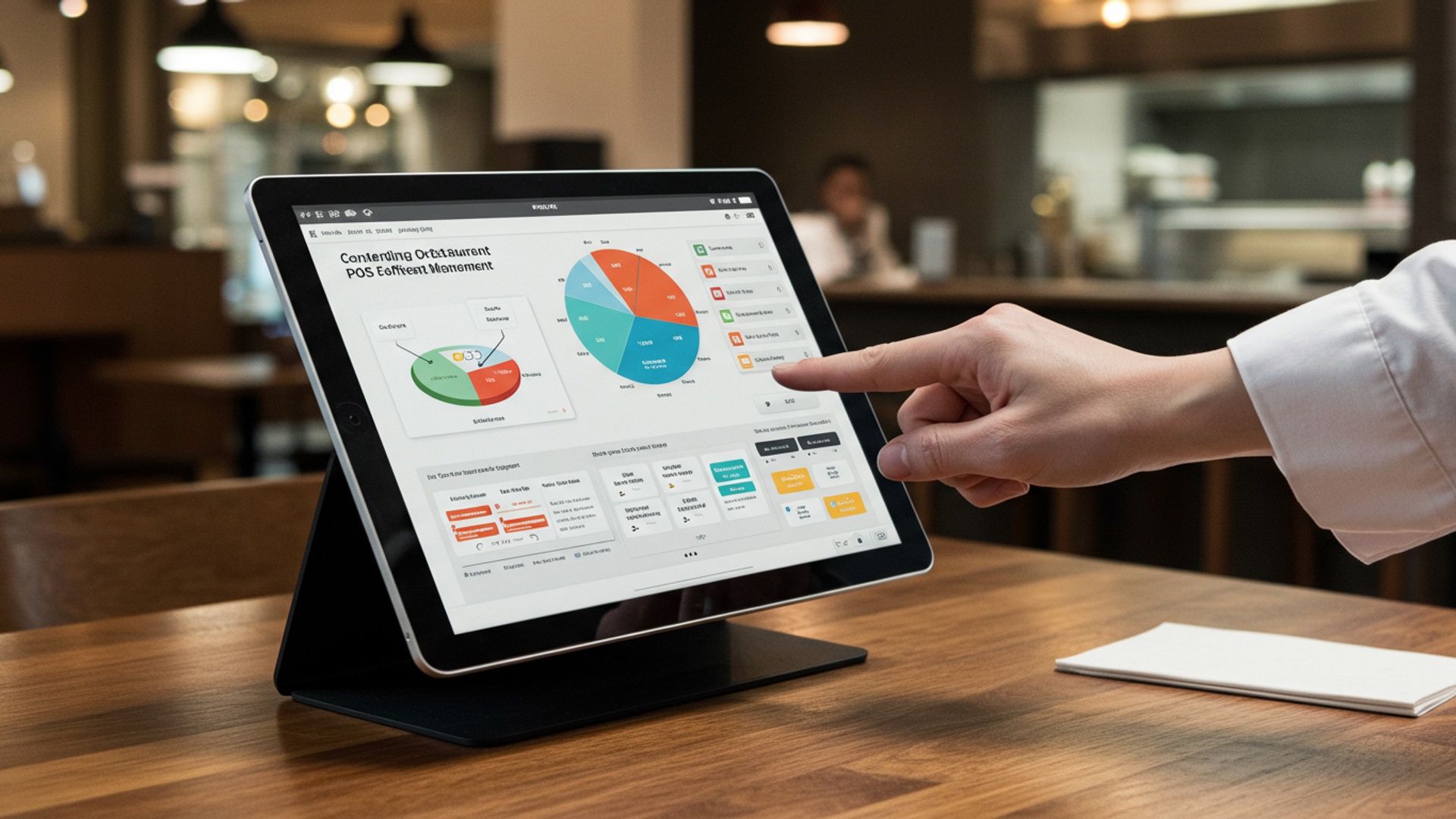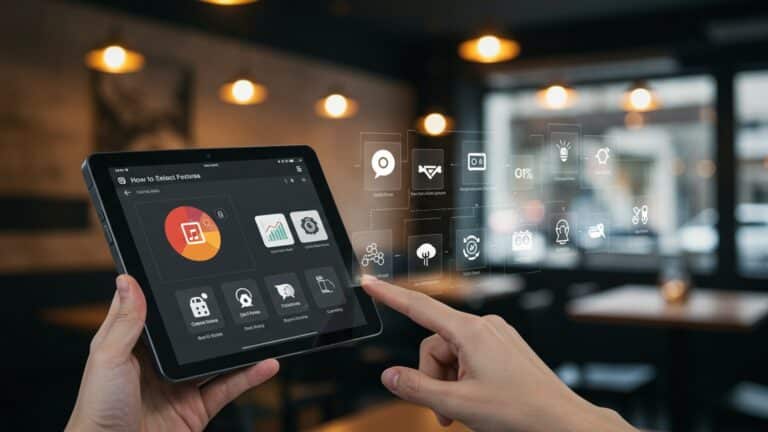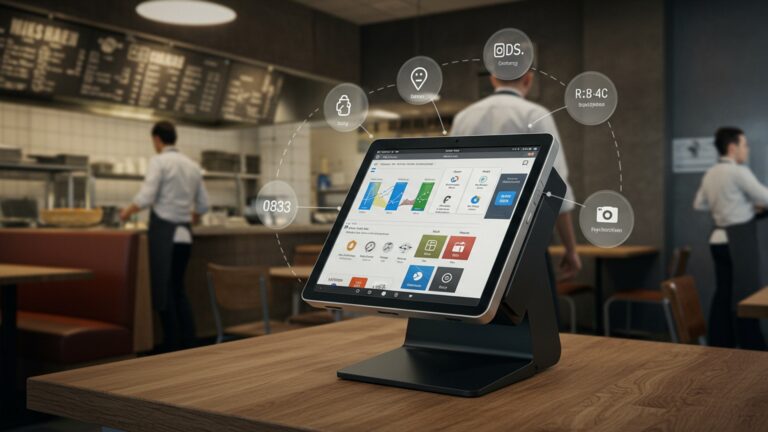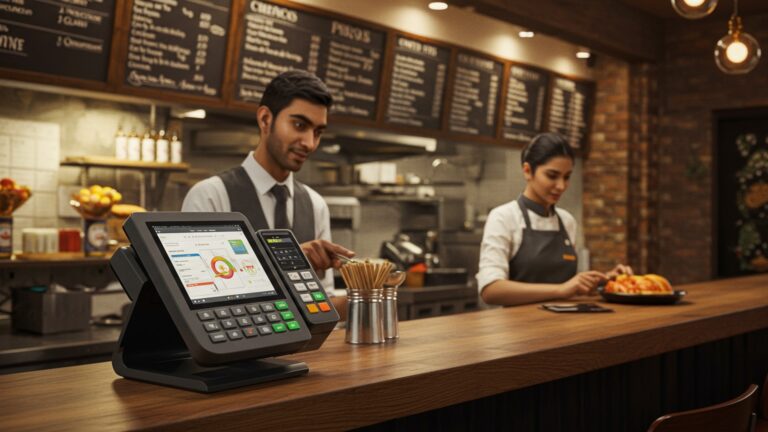Mastering Restaurant POS Software A Comprehensive Guide for Efficient Management
Modern restaurant operations demand more than just a cash register; they require a sophisticated ecosystem where every transaction, inventory movement. staff interaction converges. Efficient restaurant POS software now serves as the central nervous system, transforming raw sales data into actionable insights for profit optimization and seamless customer experiences. With recent advancements, including AI-driven predictive analytics for inventory forecasting and integrated contactless payment solutions, operators leverage these systems to manage everything from tableside ordering via handheld devices to real-time kitchen display systems (KDS) and robust loyalty programs. This technological evolution moves beyond mere processing, empowering establishments to enhance efficiency, reduce waste. elevate service quality in a highly competitive market.

The Foundation: What is Restaurant POS Software?
In the dynamic world of hospitality, efficiency is paramount. Gone are the days of manual order pads and clunky cash registers. Today, the backbone of a successful restaurant operation is sophisticated restaurant POS software. POS, which stands for Point of Sale, refers to the place where a retail transaction is completed. For restaurants, this means far more than just processing payments; it’s an integrated system that manages every aspect of a customer’s journey and a restaurant’s daily operations.
At its core, restaurant POS software is a comprehensive system designed to streamline and automate the entire order and payment process. Think of it as the central nervous system of your establishment, connecting the front-of-house (FOH) to the back-of-house (BOH). While traditional cash registers merely recorded sales, modern POS systems are powerful platforms that offer a suite of tools to enhance efficiency, improve customer service. provide invaluable insights into business performance. From taking orders to managing inventory and tracking sales trends, a robust restaurant POS software solution is indispensable for any modern eatery aiming for peak performance.
Core Features of Essential Restaurant POS Software
To truly master your restaurant’s operations, understanding the key features of your restaurant POS software is crucial. These functionalities are designed to address the unique challenges of the food service industry and empower owners and managers with greater control and visibility.
- Order Management
- Payment Processing
- Inventory Management
- Employee Management
- Reporting & Analytics
- Customer Relationship Management (CRM)
- Kitchen Display Systems (KDS)
- Online Ordering & Delivery Integration
This is the heart of any restaurant POS system. It includes intuitive interfaces for taking orders (both dine-in and takeout), customisable menus with modifiers (e. g. , “extra cheese,” “no onions”), split checks, table management. the ability to send orders directly to the kitchen or bar.
Beyond basic credit card swipes, modern restaurant POS software supports various payment methods, including contactless payments (NFC), mobile payments, gift cards. even integrated online payment gateways. Secure EMV compliance is a standard, protecting both your business and your customers.
An often-underestimated feature, inventory management tracks ingredients from supplier delivery to plate. It helps monitor stock levels, set reorder points, identify popular and slow-moving items. ultimately reduce waste and food costs. Some advanced systems can even calculate theoretical food costs versus actual.
This module typically includes time clock functionality for staff clock-ins and outs, payroll integration, shift scheduling, performance tracking. granular access controls, ensuring employees only access features relevant to their roles.
This is where data transforms into actionable insights. Comprehensive reports on sales trends, peak hours, popular dishes, employee performance. cost analysis help make informed business decisions, optimise staffing. refine menu offerings.
Building customer loyalty is vital. Many restaurant POS software solutions offer integrated CRM features like loyalty programs, gift card management, customer profiles. tools for gathering feedback and sending targeted promotions.
Integrating a KDS with your restaurant POS software replaces paper tickets in the kitchen. Orders appear instantly on screens, streamlining communication, reducing errors. speeding up kitchen operations.
In today’s digital age, seamless integration with online ordering platforms, third-party delivery services. even your own website is a non-negotiable. This expands your reach and caters to changing customer preferences.
Types of Restaurant POS Systems: Cloud vs. On-Premise
When selecting restaurant POS software, one of the most fundamental decisions involves choosing between a cloud-based (SaaS) system and an on-premise (legacy) system. Each has distinct advantages and disadvantages that cater to different operational needs and budgets.
| Feature | Cloud-Based Restaurant POS Software | On-Premise Restaurant POS Software |
|---|---|---|
| Definition | Software hosted on the vendor’s servers, accessible via the internet from any device. | Software installed directly on your restaurant’s local servers and computers. |
| Cost Structure | Typically a monthly or annual subscription fee. Lower upfront cost. | High upfront cost for software licenses and hardware; lower ongoing fees (maintenance). |
| Accessibility | Access data and manage operations from anywhere with an internet connection (e. g. , home, multiple locations). | Primarily accessible within the restaurant’s physical network. Remote access often requires complex VPN setups. |
| Updates & Maintenance | Automatic updates and maintenance handled by the vendor. No manual effort required. | Requires manual updates, patches. IT support from your team or a third party. |
| Hardware Needs | Often runs on standard tablets (iPad, Android) or slim terminals, reducing hardware costs. | Typically requires dedicated, robust POS terminals and local servers. |
| Data Security | Vendor is responsible for data security, backups. disaster recovery. Often uses enterprise-grade security. | Restaurant is solely responsible for data security, backups. disaster recovery. |
| Scalability | Highly scalable; easy to add new terminals or locations with minimal effort. | Scaling requires additional hardware purchases and complex network configurations. |
A real-world example highlights these differences: A burgeoning chain, “Urban Eats,” chose a cloud-based restaurant POS software. This allowed their managers to monitor sales, adjust menus. manage staff schedules across all five locations from a single dashboard, even when traveling. When they opened their sixth location, adding it to the system was a matter of minutes, not days. Conversely, a long-established fine-dining restaurant, “The Gilded Spoon,” initially relied on an on-premise system tailored precisely to their unique, complex workflow. While robust and reliable within its single location, expanding its digital capabilities or accessing data remotely proved cumbersome and costly, eventually prompting a partial shift to hybrid solutions for specific functions like online reservations.
Key Benefits of Implementing Robust Restaurant POS Software
Investing in the right restaurant POS software is not just about keeping up with technology; it’s about securing a competitive edge and fostering sustainable growth. The benefits extend across every facet of a restaurant’s operation.
- Increased Operational Efficiency
- Enhanced Customer Experience
- Improved Decision-Making (Data-Driven)
- Reduced Costs & Waste
- Better Security & Compliance
- Streamlined Employee Management
From faster order taking and seamless kitchen communication via KDS to automated inventory tracking, a good POS system drastically reduces manual tasks and streamlines workflows. This means less waiting time for customers and more productive staff.
Quick and accurate order processing, flexible payment options. integrated loyalty programs all contribute to a smoother, more enjoyable experience for your patrons. Happy customers are repeat customers.
The wealth of data generated by restaurant POS software—sales trends, peak periods, popular menu items, employee performance—provides invaluable insights. This allows owners to make informed decisions on staffing, menu engineering, marketing efforts. inventory purchases, moving away from guesswork.
Precise inventory management helps minimise food waste and spoilage, while detailed sales reports can highlight unprofitable menu items. Efficient labor scheduling based on sales data also helps control payroll costs.
Modern POS systems offer robust security features, including encrypted payment processing (PCI compliance), secure data storage. user access controls. This protects sensitive customer details and safeguards against internal theft.
Automated time clocks simplify payroll, while performance reports can help identify training needs or reward top performers. Clear communication channels through the system also reduce errors and improve team cohesion.
Choosing the Right Restaurant POS Software: A Strategic Approach
The market is flooded with various restaurant POS software options, each promising to be the best. Making the right choice requires a strategic approach, aligning the software’s capabilities with your specific business needs and future goals.
- Assess Your Restaurant’s Specific Needs
- Type of Restaurant
- Size and Scale
- Current Challenges
- Scalability
- Integration Capabilities
- User-Friendliness & Training
- Support & Reliability
- Demo and Trial Periods
A fast-casual eatery will have different needs than a fine-dining establishment, a food truck, or a multi-location chain. Do you need extensive table management, quick order entry, or robust delivery integration?
Consider the number of terminals, employees. locations. Your budget will also play a significant role here.
Identify your biggest pain points. Is it slow order processing, inventory waste, or difficulty tracking sales? Choose a system that directly addresses these issues.
Your restaurant may grow. Ensure the restaurant POS software can scale with you, easily accommodating additional terminals, locations, or new features without requiring a complete system overhaul.
A truly powerful POS system doesn’t operate in a silo. Check its ability to integrate seamlessly with other essential tools like accounting software (e. g. , QuickBooks), online ordering platforms, loyalty programs. third-party delivery services. This avoids data silos and improves overall efficiency.
An intuitive interface is paramount. If your staff finds the system difficult to use, it will lead to errors, frustration. slow service. Look for systems that offer clear, logical workflows and provide comprehensive training resources.
What kind of customer support does the vendor offer? 24/7 support is often critical for restaurants, as issues can arise at any time. Look for reliable hardware and software, with clear service level agreements (SLAs).
Never commit without a thorough test drive. Take advantage of demos and free trial periods to see how the system performs in your actual restaurant environment. Get your staff involved in the testing process.
A recent case study involved “The Daily Grind,” a popular coffee shop chain. Their old system struggled with peak morning rush orders and lacked loyalty program integration. After evaluating several restaurant POS software options, they chose one that excelled in quick order processing, offered a robust built-in loyalty system. provided seamless integration with their existing accounting software. This strategic choice not only sped up service but also allowed them to launch a successful loyalty program that significantly increased repeat business.
Implementing and Maximizing Your Restaurant POS Software
Once you’ve chosen your restaurant POS software, the journey isn’t over. Effective implementation and ongoing optimisation are key to unlocking its full potential and ensuring it truly drives efficient management.
- Thorough Planning and Setup
- Menu Configuration
- Hardware Installation
- Network Infrastructure
- Comprehensive Staff Training
- Conduct hands-on training sessions for FOH (order entry, payment processing, table management) and BOH (KDS operation, inventory receiving).
- Create simple, accessible cheat sheets for quick reference.
- Designate a few “POS champions” among your staff who can assist peers and troubleshoot minor issues.
- Data Migration
- Regular Updates and Maintenance
- Leveraging Analytics for Growth
- Daily Reviews
- Weekly Deep Dives
- Monthly Strategic Planning
Dedicate time to meticulously set up your entire menu, including categories, subcategories, modifiers, pricing. ingredient details for inventory tracking.
Ensure all hardware (terminals, printers, KDS screens, payment devices) is correctly installed and networked.
Verify your internet connection and local network are robust enough to support the system, especially for cloud-based solutions.
This is arguably the most critical step. Don’t just show staff how to take an order; train them on every feature relevant to their role.
If you’re switching from an older system, carefully plan the migration of existing data, such as customer data, loyalty points. historical sales data, to ensure a smooth transition.
For cloud-based systems, updates are often automatic. For on-premise solutions, schedule regular maintenance and updates to ensure security and access to new features. Regularly back up your data regardless of the system type.
Don’t let your valuable data sit idle.
Start by reviewing daily sales reports to identify immediate trends or issues.
Conduct weekly analyses of popular items, slow movers. inventory discrepancies. Use this to adjust ordering, menu placement, or promotions.
Leverage monthly reports to inform long-term decisions on menu changes, marketing campaigns. staff scheduling. For example, if your restaurant POS software shows a consistent dip in sales on Tuesdays, you might consider a “Taco Tuesday” promotion.
Consider the example of “Mama Mia’s Pizzeria.” When they first implemented their new restaurant POS software, they faced initial resistance from long-term staff. But, by investing in extensive, interactive training sessions, creating a user-friendly manual. having managers provide constant support during the first few weeks, the transition was successful. Within months, their order accuracy improved by 15%. table turnover increased by 10% during peak hours, directly attributable to the streamlined workflow enabled by the POS system and the staff’s proficiency in using it. This demonstrates that the technology is only as good as the people operating it.
Conclusion
Mastering restaurant POS software isn’t merely about processing transactions; it’s about unlocking operational excellence and elevating the entire dining experience. By diligently applying the strategies discussed, you transform your POS from a simple cash register into a dynamic hub for inventory control, staff management. insightful data analytics. My personal tip? Regularly dedicate time to explore your system’s advanced features, like setting up dynamic pricing for happy hour or leveraging integrated online ordering as current trends demand. Remember, the latest cloud-based POS systems, for instance, offer unparalleled real-time data access, crucial for making agile business decisions in today’s fast-paced culinary world. I once saw a restaurant dramatically reduce food waste by simply analyzing daily sales reports from their POS, a simple yet powerful insight. Don’t just settle for basic functionality; push the boundaries. Embrace continuous learning and empower your team to become POS pros. Your restaurant’s efficiency, profitability. customer satisfaction will undeniably soar, paving the way for sustained success.
More Articles
How to Select the Best POS Software Guide for Business Efficiency
Guide to 10 Best Cloud-based Restaurant POS India Systems for Efficiency
Learn 5 Essential Online Ordering POS India Features for Your Restaurant
Master Restaurant Billing Software India Choose Your Perfect System
Top 7 Affordable Restaurant POS India Solutions for Smart Owners
FAQs
So, what’s ‘Mastering Restaurant POS Software’ all about?
This guide is your comprehensive resource for understanding and effectively using Point of Sale (POS) software in a restaurant setting. It covers everything from the foundational basics to advanced features, aiming to help you streamline operations and boost efficiency.
Who should really read this guide? Is it for me?
Absolutely! Whether you’re a restaurant owner, manager, a new employee learning the ropes, or even someone considering opening a restaurant, this guide is packed with valuable insights. It’s designed for anyone looking to optimize their restaurant management through smart POS utilization.
Why bother mastering POS software anyway? What’s the big deal?
Mastering your POS system is a game-changer for operational efficiency. It helps you speed up order processing, manage inventory more accurately, track sales data, reduce errors. ultimately improve both the customer experience and your restaurant’s profitability.
What kind of topics does the guide dive into?
The guide is quite comprehensive! It covers selecting the right POS system, initial setup, order and table management, inventory control, staff management features, robust reporting and analytics, payment processing. even troubleshooting common issues. It’s a holistic view of the entire POS ecosystem.
Will this guide help me pick the best POS system for my restaurant?
While it doesn’t endorse specific brands, the guide provides a detailed framework and highlights key considerations to help you evaluate different POS systems. It equips you with the knowledge needed to make an informed decision that perfectly aligns with your restaurant’s unique needs and budget.
I’m not very tech-savvy. Is this guide going to be too complicated for me?
Not at all! The guide is written to be accessible to everyone, regardless of their tech background. It explains complex concepts in simple terms and offers practical, step-by-step advice, making it easy for anyone to follow along and confidently master their POS system.
How does effective POS management actually boost my restaurant’s bottom line?
By streamlining daily operations, reducing waste through precise inventory control, minimizing order errors, accelerating service times. providing valuable sales data for strategic business decisions, effective POS management directly contributes to increased revenue and reduced operational costs, significantly boosting your overall profitability.






